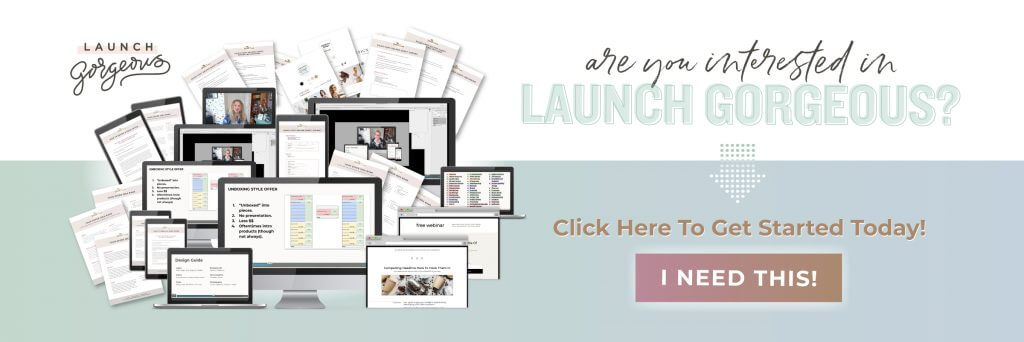
This is going to be the “‘splain it to me like I’m five” Funnel Building for Beginners Guide. Be sure to check out our FREE mini course for even more!
A funnel is a type of website. Gasp. I know. In the online world, funnels and websites are always pitted against each other, but really—if we boil it down—a funnel is just a series of webpages arranged in a certain order to get people to take action.
Now, they are arranged quite differently than a website. And, yes, they do something different than a website does, but still—it’s just WEBPAGES.
Websites are like brochures. You show up to the site and there are a ton of options to choose from. Funnels are different. They have ONE thing for you to do, and once you do that thing, they offer you something else, and something else, and so on.
You can build a funnel with any software that you can build a website with. The most popular website builder is WordPress, and funnels can be built with this same tool. However, when you think about the function of a website vs. a funnel, you’ll start to see where the similarities drop off.
They may also have forms to fill out, or if you’re in ecommerce, you might have a shopping area. But unless you’re building a really intense website, most of them only need minimal functionality. As long as it holds words, pictures, and videos, you’re probably good.
Therefore, 99% of funnels (except the ones for JUST lead generation) have an order form, or a cart with one product to buy.
So in addition to having words, pictures, video, you also need a place to take money.
The funnel is also designed to encourage the buyer to buy MORE than just one product, so after offering the one thing, there are usually upsells and order bumps and extras to add on, adding further complexity to the webpage.
That’s why there are all kinds of funnel building tools on the market now. ClickFunnels, Kartra, Ontraport, Kajabi, GroovePages, and more. These are hosted solutions where you pay a monthly fee and get access to their funnel building tools. Yes, you can still build funnels on WordPress, but you’ll more than likely need a suite of plugins (such as Elementor) to get it to do the things you want.

Inside of our Funnel Rx program, we take you behind the scenes into the world of funnel building. We offer this $97 program after your purchase of our signature Offer Cure class, and we highly recommend it so you can get a deep understanding of funnel strategy.
But let’s talk a bit about what actually makes a funnel a funnel.
A funnel has five main assets:
The sales asset is the webpage or series of pages that ACTUALLY sells the thing you’re trying to sell.
The cart asset is the checkout. This is where money is exchanged.
The delivery asset is the mechanism by which the customer actually gets what they paid for. (In a lot of online businesses, this is the members area.)
The follow up asset is the mechanism by which you follow up with customers or leads (if they didn’t purchase). The most common example is the members area, but it could also be a retargeting ad, an abandoned cart email sequence, or something along those lines.
And, finally, the traffic asset is the most variable of the assets. You could (and should) have multiple traffic assets. These are the things you do to get people to SEE your funnel. (E.g. ads, SEO, social media, joint ventures, etc.)
Some tools boast that they can do everything but the traffic. That means the webpages, checkout area, emails, and membership are all included. Kartra and ClickFunnels are examples of platforms that do it all.
Other software does ONE part really well. For example, ConvertKit is a great follow up asset tool. Teachable is an excellent delivery asset tool.
It’s really up to personal choice if you want an all-in-one solution, or if you prefer to piecemeal it. There are advantages to both models.
When you have an all-in-one solution, you don’t have to worry to much about tech. You have one monthly payment, etc. However, the features can be limited, and if something happens with that software, you’re stuck.
When you have it piecemeal, you usually get more feature-rich software to use. However, you will have more tech integrations and multiple monthly payments.
At Funnel Gorgeous, we actually prefer the piecemeal approach because we love different software for different uses.
Funnel building is a super addicting + fun thing to do. Whether you’re a business owner trying to launch one funnel for a product, or you’re considering a freelance or agency business building funnels for others, we’ve got you covered.
First, we have two signature coaching programs for each possibility. If you’re a business owner trying to get a funnel launched, we’d love to invite you to Launch Gorgeous.
If you’re thinking of becoming an agency or freelance funnel builder, our certification program FG Society, might be the best fit!
That said, let’s get to the general scope of what it means to build a funnel.
Here are the most common goals:
Some funnels will do just ONE thing. Others will do all three in one funnel.
For example, a lead funnel will be a simple two-page funnel where you collect the email address on page one, and thank them for doing so on page two.
A sales funnel has the goal of making a sale. (Which means you also collect the lead information as well!)
When you have a webinar funnel, you’ll get the lead to register for the event, watch the event, and then buy the product at the end.
Pick out your goal. That’s step one.
A lot of people ask us, “Why do you call it an offer? Isn’t it a product?”
An offer is not just the product itself—it’s the extras that come along with it. A lot of people don’t realize that 70% of the work of creating a funnel is coming up with an amazing offer. This is one of the reasons we built our program Offer Cure. We knew if we could teach people about how to make an offer, they would have success more quickly!
Outline your offer, and all the cool extras it’ll include. And, if you decide to have upsells, what might those other products be?
Once you’ve got your offer idea, it’s time to write sales copy. This is the messaging you’ll use to convince your lead this offer is something they want to buy!
This part is the most fun (and at first can feel really intimidating). You’ll definitely want to head over to our template shop and start with a template. It’s way easier than designing from scratch! The best part about our templates is we give you all the extra graphics in 25 additional colors so you can truly create a custom look.
This is the most technical part. Hook up all your pages so that you can easily take your lead from one page to the next. Connect your payment gateway so you can accept money (e.g. Stripe or Paypal). Then hook up your follow up assets. Most of the time this is simply an email service to follow up with people who didn’t purchase. Lastly, make sure the members area, or whatever delivery asset you have, is connected for post checkout.
All kinds! Whether you’re a service-based business, a brick and mortar, or are in ecommerce, infoproduct marketing, or software, any business that chooses to advertise online can and should use funnels!
You want to focus on the few products that generate the most revenue for your business. These are the things you want to sell in a funnel, because when you’re advertising on social media, it’s easy for your leads to get distracted and bounce off a generic link to a website. A strategic and psychology-informed funnel will help your potential customer stay focused and do the thing you want them to do: Buy!
Here are a few examples of how businesses are using funnels…
Accountant – This type of business might build a simple lead funnel where they offer a FREE budget calculator in exchange for an email address. Once the leads downloads the product, they can now follow up with emails to hopefully secure them as a new client.
Restaurant – A restaurant might also use a lead funnel as well, asking for an email address in exchange for a 20% your next dinner coupon. Now that they have the person’s contact info, they can email them promotions.
Online store selling beauty products – In this case, the shop owner would want to look at the bestselling items in the shop. Which things are people buying in a bundle or offer? Once they’ve got that figured out, they’d build a simple sales funnel that offers ONE product first, and then asks them if they want to add something to their order at checkout. After checkout, you might flash a one time offer upsell that gives them a chance to add another product to their order.
Coach selling coaching program – For this type of business, you might build an application funnel. The first page is a video case study, and at the bottom of the page, the lead is offered to opt in with an email address to fill out an application. After that’s complete, they are redirected to a calendar link to book a call.
Course creator selling a $1000 course – A webinar funnel would work best in this scenario. You’d create a free registration page for people to put in their email address and register for the class. At the class, you’d sell them your course and they’d go and check out at the end!
Building a funnel uses three core skills…
If you have three different people working on your funnel, you can build one fairly quickly—especially if the product is already made.
It would take about one week’s worth of work to get it out the door from nothing if you had a team.
If it’s just you, and you’re a beginner, we like to give people between 6-12 weeks to fully build out a funnel from start to finish. (Which includes creating the product.)
While that may seem like a long time, the truth is that a well-built funnel can make you millions of dollars. It’s really not that much time in the grand scheme of things!
Our Launch Gorgeous program is perfect for those going it alone—we hold your hand each step of the way + you get to join a community of people who are also gearing up to launch!

And, we also have created an ENTIRE shop of templates to help make your job easier. It’s over at Funnel Gorgeous!
